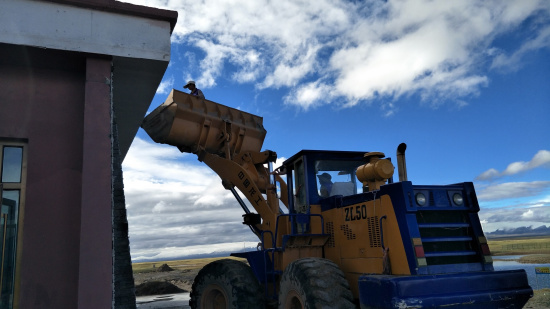
A worker is installing the CCTV camera. /CGTN Photo
The recent installation of a satellite communication system can help Hoh Xil, China's largest uninhabited area, become a less dangerous place to live.
Hoh Xil, located in the northwestern part of the Qinghai-Tibet Plateau in China, has an average altitude of 4,600 meters which makes the living conditions there severe. The patrollers of Hoh Xil know that each inspection in the wild can possibly end their lives.
The satellite communication system installed on Tuesday is set to help the region get online and bring dangerous outdoor inspections indoors. The system was established in the Sanandaj Natural Protection Station named after the man died protecting antelopes in the region.
"We're all very happy about this. Back then we had to travel a long way to make a phone call, but now we can surf the Internet and have video chats. It connects us to the rest of the world," said Lhungdrup Tsagyal, Deputy Director of the protection station.
Liu Baocai, whose company installed the system alongside China Telecom, told CGTN that the satellite communication in Hoh Xil is even faster than normal fiber-optic broadband. It has the potential to completely change how protection work is done in the region.
For the next step, all protection stations, monitoring points, and patrolling routes in Hoh Xil will be added to the satellite network. The network is set to provide communication services to rescue and patrol teams, and ecosystem and rare animal monitoring. Qi Binghui, the Marketing Manager of China Telecom, said this will ultimately set up a smart network in Hoh Xil.
Liu also envisioned a future of IoT, also known as the Internet of Things, in Hoh Xil when all patrollers would no longer spend weeks in dangerous living conditions instead only have to watch the surveillance cameras monitoring real-time changes in Hoh Xil.
It is not all sunshine and rainbows at the beginning. So far the signal of the system only covers an area with a radius of 1 kilometer, far smaller than Hoh Xil's 45,000-square-kilometer natural reserve, but the work here is not done.
Hoh Xil Wildlife Conservation Association who participated in the program plans to build a network of satellite communication in 18 months and establish an Internet of Things network in Hoh Xil in the following three to four years. The experience would be utilized in China's other natural reserves if they succeeded.


















































